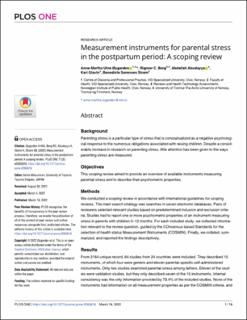| dc.contributor.author | Øygarden, Anne-Martha Utne | |
| dc.contributor.author | Berg, Rigmor C. | |
| dc.contributor.author | Abudayya, Abdallah | |
| dc.contributor.author | Glavin, Kari | |
| dc.contributor.author | Strøm, Benedicte Sørensen | |
| dc.date.accessioned | 2022-03-25T09:07:05Z | |
| dc.date.available | 2022-03-25T09:07:05Z | |
| dc.date.created | 2022-03-23T22:26:49Z | |
| dc.date.issued | 2022 | |
| dc.identifier.citation | PLOS ONE. 2022, 1-18. | en_US |
| dc.identifier.issn | 1932-6203 | |
| dc.identifier.uri | https://hdl.handle.net/11250/2987564 | |
| dc.description | This is an open access article distributed under the terms of the Creative Commons Attribution License, which permits unrestricted use, distribution, and reproduction in any medium, provided the original author and source are credited. | en_US |
| dc.description.abstract | Background: Parenting stress is a particular type of stress that is conceptualized as a negative psychological response to the numerous obligations associated with raising children. Despite a considerable increase in research on parenting stress, little attention has been given to the ways parenting stress are measured.
Objectives: This scoping review aimed to provide an overview of available instruments measuring parental stress and to describe their psychometric properties.
Methods: We conducted a scoping review in accordance with international guidelines for scoping reviews. The main search strategy was searches in seven electronic databases. Pairs of reviewers selected relevant studies based on predetermined inclusion and exclusion criteria. Studies had to report one or more psychometric properties of an instrument measuring stress in parents with children 0–12 months. For each included study, we collected information relevant to the review question, guided by the COnsensus based Standards for the selection of health status Measurement INstruments (COSMIN). Finally, we collated, summarized, and reported the findings descriptively.
Results: From 2164 unique record, 64 studies from 24 countries were included. They described 15 instruments, of which four were generic and eleven parental-specific self-administered instruments. Only two studies examined parental stress among fathers. Eleven of the studies were validation studies, but they only described seven of the 15 instruments. Internal consistency was the only information provided by 73.4% of the included studies. None of the instruments had information on all measurement properties as per the COSMIN criteria, and there was no information about measurement error, responsiveness, or interpretability for any of the 15 instruments.
Discussion: There are presently 15 instruments with some associated psychometric information being used to measure parental stress among parents with young children, but the amount of information on the instruments’ psychometric properties is slight. There is a need for further research. | en_US |
| dc.language.iso | eng | en_US |
| dc.publisher | Public Library of Science (PLOS) | en_US |
| dc.relation.uri | https://doi.org/10.1371/journal.pone.0265616 | |
| dc.rights | Navngivelse 4.0 Internasjonal | * |
| dc.rights.uri | http://creativecommons.org/licenses/by/4.0/deed.no | * |
| dc.subject | Foreldre | en_US |
| dc.subject | Parents | en_US |
| dc.subject | fathers | en_US |
| dc.subject | depression | en_US |
| dc.subject | birth | en_US |
| dc.subject | mothers | en_US |
| dc.subject | database searching | en_US |
| dc.subject | psychometrics | en_US |
| dc.subject | measurement | en_US |
| dc.subject | psychological stress | en_US |
| dc.title | Measurement instruments for parental stress in the postpartum period: A scoping review | en_US |
| dc.type | Peer reviewed | en_US |
| dc.type | Journal article | en_US |
| dc.description.version | publishedVersion | en_US |
| dc.rights.holder | Copyright: © 2022 Øygarden et al. | en_US |
| dc.subject.nsi | VDP::Sykepleievitenskap: 808 | en_US |
| dc.subject.nsi | VDP::Nursing science: 808 | en_US |
| dc.source.pagenumber | 1-18 | en_US |
| dc.source.journal | PLOS ONE | en_US |
| dc.identifier.doi | 10.1371/journal.pone.0265616.s001 | |
| dc.identifier.cristin | 2012137 | |
| cristin.ispublished | true | |
| cristin.fulltext | original | |
| cristin.qualitycode | 1 | |

